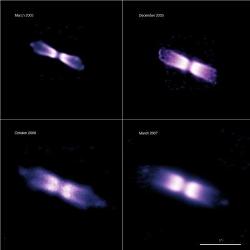Nov 17 2009
“One of the major problems in modern astrophysics is the fact that we still do not know exactly what kinds of stellar system explode as a Type Ia supernova,” says Patrick Woudt, from the University of Cape Town and lead author of the paper reporting the results. “As these supernovae play a crucial role in showing that the Universe’s expansion is currently accelerating, pushed by a mysterious dark energy, it is rather embarrassing.”
 The expanding shell around V445 Puppis
The expanding shell around V445 Puppis
The astronomers studied the object known as V445 in the constellation of Puppis (“the Stern”) in great detail. V445 Puppis is the first, and so far only, nova showing no evidence at all for hydrogen. It provides the first evidence for an outburst on the surface of a white dwarf dominated by helium. “This is critical, as we know that Type Ia supernovae lack hydrogen,” says co-author Danny Steeghs, from the University of Warwick, UK, “and the companion star in V445 Pup fits this nicely by also lacking hydrogen, instead dumping mainly helium gas onto the white dwarf.”
In November 2000, this system underwent a nova outburst, becoming 250 times brighter than before and ejecting a large quantity of matter into space.
The team of astronomers used the NACO adaptive optics instrument on ESO’s Very Large Telescope (VLT) to obtain very sharp images of V445 Puppis over a time span of two years. The images show a bipolar shell, initially with a very narrow waist, with lobes on each side. Two knots are also seen at both the extreme ends of the shell, which appear to move at about 30 million kilometres per hour. The shell — unlike any previously observed for a nova — is itself moving at about 24 million kilometres per hour. A thick disc of dust, which must have been produced during the last outburst, obscures the two central stars.
“The incredible detail that we can see on such small scales — about hundred milliarcseconds, which is the apparent size of a one euro coin seen from about forty kilometres — is only possible thanks to the adaptive optics technology available on large ground-based telescopes such as ESO’s VLT,” says Steeghs.
A supernova is one way that a star can end its life, exploding in a display of grandiose fireworks. One family of supernovae, called Type Ia supernovae, are of particular interest in cosmology as they can be used as “standard candles” to measure distances in the Universe and so can be used to calibrate the accelerating expansion that is driven by dark energy.
One defining characteristic of Type Ia supernovae is the lack of hydrogen in their spectrum. Yet hydrogen is the most common chemical element in the Universe. Such supernovae most likely arise in systems composed of two stars, one of them being the end product of the life of sun-like stars, or white dwarfs. When such white dwarfs, acting as stellar vampires that suck matter from their companion, become heavier than a given limit, they become unstable and explode.
The build-up is not a simple process. As the white dwarf cannibalises its prey, matter accumulates on its surface. If this layer becomes too dense, it becomes unstable and erupts as a nova. These controlled, mini-explosions eject part of the accumulated matter back into space. The crucial question is thus to know whether the white dwarf can manage to gain weight despite the outburst, that is, if some of the matter taken from the companion stays on the white dwarf, so that it will eventually become heavy enough to explode as a supernova.